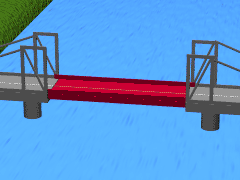Vertical-lift bridge
 An animation showing how a vertical-lift bridge operates with vehicular and shipping traffic | |
| Ancestor | Truss bridge |
|---|---|
| Related | Bascule bridge, swing bridge, folding bridge, retractable bridge |
| Descendant | Submersible bridge, table bridge |
| Carries | Automobile, pedestrians, truck, light rail, heavy rail |
| Span range | Short |
| Material | Steel |
| Movable | Yes |
| Design effort | medium |
| Falsework required | Depends upon degree of prefabrication |
A vertical-lift bridge or just lift bridge is a type of movable bridge in which a span rises vertically while remaining parallel with the deck.
The vertical lift offers several benefits over other movable bridges such as the bascule and swing-span bridge. Generally speaking they cost less to build for longer moveable spans.[1] The counterweights in a vertical lift are only required to be equal to the weight of the deck, whereas bascule bridge counterweights must weigh several times as much as the span being lifted. As a result, heavier materials can be used in the deck, and so this type of bridge is especially suited for heavy railroad use.
Although most vertical-lift bridges use towers, each equipped with counterweights, some use hydraulic jacks located below the deck. An example is the 52-foot (15.85 m) span bridge at St Paul Avenue in Milwaukee[2] (see also table bridges). Another design used balance beams to lift the deck, with pivoting bascules located on the top of the lift towers.[3] An example of this kind was built at La Salle in Illinois, USA.
The biggest disadvantage to the vertical-lift bridge (in comparison with many other designs) is the height restriction for vessels passing under it. This is a result of the deck remaining suspended above the passageway.
Examples
See List of vertical-lift bridges.
Gallery of images
-
One of the vertical-lift bridges over the Gouwe River. It was built in 1930.
-
ASB Bridge in Kansas City, Missouri.
-
The Arthur Kill Vertical Lift Bridge has the longest lift span of any vertical-lift bridge in the world.
-
The Hawthorne Bridge (in Portland, Oregon, U.S.), built in 1910, the oldest vertical-lift bridge in the United States[4] and probably the world.
-
A lift bridge over the Erie Canal at Lockport...
-
...elevates at both ends...
-
...and nears its upward position. Pedestrians may cross when it is up using stairways.
See also
- Moveable bridges for a list of other movable bridge types
- Submersible bridge for a similar disappearing bridge
- Table bridge for a vertical-lift bridge without visible lifting means
References
Bibliography
- Leonardo Fernandez Troyano (2003). Bridge Engineering: A Global Perspective. Thomas Telford Publishing. ISBN 978-0-7277-3215-6.
External links
 Media related to Vertical-lift bridges at Wikimedia Commons
Media related to Vertical-lift bridges at Wikimedia Commons




![The Hawthorne Bridge (in Portland, Oregon, U.S.), built in 1910, the oldest vertical-lift bridge in the United States[4] and probably the world.](http://upload.wikimedia.org/wikipedia/commons/thumb/2/2b/Hawthorne_Bridge_%28Portland%2C_Oregon%29_from_southwest%2C_2012.jpg/120px-Hawthorne_Bridge_%28Portland%2C_Oregon%29_from_southwest%2C_2012.jpg)



